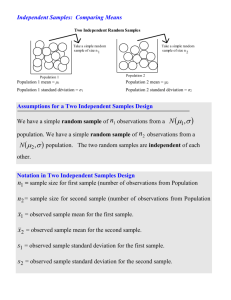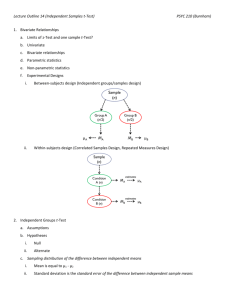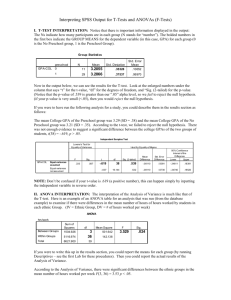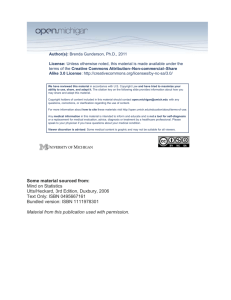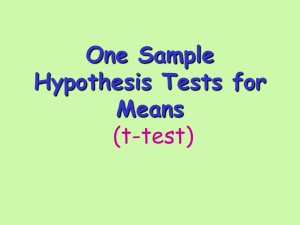Independent Samples: Comparing Means
advertisement
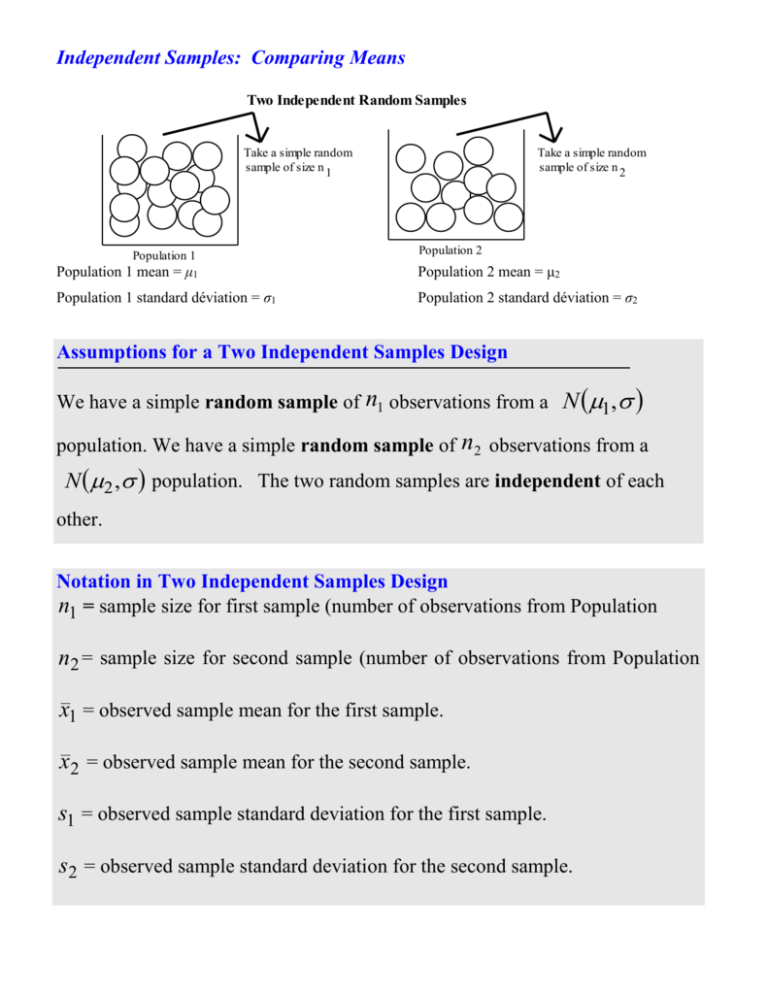
Independent Samples: Comparing Means Two Independent Random Samples Take a simple random sample of size n 1 Population 1 Take a simple random sample of size n 2 Population 2 Population 1 mean = μ1 Population 2 mean = μ2 Population 1 standard déviation = σ1 Population 2 standard déviation = σ2 Assumptions for a Two Independent Samples Design We have a simple random sample of n1 observations from a N 1, population. We have a simple random sample of n2 observations from a N 2 , population. The two random samples are independent of each other. Notation in Two Independent Samples Design n1 = sample size for first sample (number of observations from Population n2 = sample size for second sample (number of observations from Population x1 = observed sample mean for the first sample. x2 = observed sample mean for the second sample. s1 = observed sample standard deviation for the first sample. s2 = observed sample standard deviation for the second sample. Testing the Difference Between Two Means of Independent Samples Design There are actually two different options for the use of t tests. One option is used when the variances of the populations are not equal, and the other option is used when the variances are equal. To determine whether two sample variances are equal, the researcher can use an F test. Note, however, that not all statisticians are in agreement about using the F test before using the t test. Some believe that conducting the F and t tests at the same level of significance will change the overall level of significance of the t test. Their reasons are beyond the scope of this course. Assumptions: - Both populations are normally distributed -The samples are obtained independently Not satisfied Non-parametric method are used TEST if the variances of two normally distributed populations Satisfied are different H 0: 12 22 H1 : 12 22 Using F-test Did not reject Reject Pooled T-test H 0 : 1 2 To test To test H1 : 1 2 Use the test statistic T X 1 sp X2 d0 1 1 n1 n2 Where sp Non-pooled T-test n1 1s12 n2 1s22 n1 n2 2 H 0 : 1 2 H1 : 1 2 Use the test statistic ( x x ) ( 1 2 ) t 1 2 s12 s22 n1 n2 With approximate d.f. 2 s12 s22 n2 n1 df 2 2 s12 s22 n1 n2 n1 1 n2 1 Let’s Do It! 1 Which Version of a Two Independent Samples Test to Use? Each scenario presents a picture of the distributions of the two populations being compared. Based on these distributions, determine which version of the two-independent samples test to use. Version of Test: (select one) Pooled t-test Nonpooled t-test Nonparametric test Explain: Version of Test: Pooled t-test Nonpooled t-test Nonparametric test Explain: Version of Test: (select one) Explain: Pooled t-test Nonpooled t-test Nonparametric test Two Independent Samples Pooled t-Test We are interested in comparing the population means 1 parameter of interest is the difference 1 2 . and 2 , so the Distribution of the Standardized X 1 X 2 for the Two Independent Samples Scenario when 1 2 The quantity Where sp T X 1 sp X 2 d0 1 1 n1 n2 n1 1s12 n2 1s22 , has a t-distribution with n1 n2 2 n1 n2 2 degrees of freedom. Two Independent Samples Pooled t-Test Assumptions: The first sample is a random sample from a normal population with mean 1. The second sample is a random sample from a normal population with mean 2. The two samples are independent. Normality is less crucial if the sample sizes n1 and n2 are large, Hypotheses: H0 : 1 2 d0 versus H1 : 1 2 d0 or H0 : 1 2 d0 versus H1 : 1 2 0 or H0 : 1 2 d0 versus H1 : 1 2 0 . The significance level to be used is determined. Data: The two sets of data from which the two sample means x1 and x 2 , and the two sample standard deviations s1 and s 2 can be computed. x1 x 2 d 0 (n1 1) s12 (n2 1) s 22 t s Observed Test Statistic: where p n1 n2 2 1 1 sp n1 n2 And the t-distribution used has d.f.= (n1+ n2 – 2) p-value: We find the p-value for the test using the t(n1+ n2 - 2) distribution. The direction of extreme will depend on how the alternative hypothesis is expressed. Decision: A p-value less than Confidence Interval: where s p leads to rejection of H0 x1 x2 t * s p (n1 1) s12 (n2 1) s 22 and n1 n2 2 1 1 n1 n2 t* is an appropriate percentile of the t(n1+ n2 - 2) distribution. EXAMPLE Comparing Two Headache Treatments Medical researchers are comparing two treatments for migraine headaches. They wish to perform a doubleblind experiment to assess if Treatment 2 (the new treatment) is significantly better than Treatment 1 (the standard treatment) using a 5% significance level. The data n1 10 x1 22.6 s1 5.2 n2 10 x 2 19.4 s2 4.9 (a) State the appropriate hypotheses to be tested. Keep in mind that smaller responses imply a better treatment and Treatment 1 is the new treatment. H0 : 1 2 0 vs H1 : 1 2 0 . (b) State the conditions required for performing a two independent samples pooled t-test are satisfied. The first sample is a random sample from a normal population with mean 1 and standard deviation . The second sample is a random sample from a normal population with mean 2 but same standard deviation . The two samples are independent. (c) The mean time to relief for the Treatment 1 subjects was 22.6 minutes, with a standard deviation of 5.2 minutes. The mean time to relief for the Treatment 2 group was 19.4 minutes, with a standard deviation of 4.9 minutes. Recall that one of the assumptions for performing this test is equal population standard deviations. However, 5.2 is not equal to 4.9. Does this imply that the pooled test will not be valid? Even though the sample standard deviations of 5.2 and 4.9 are not equal, this does not mean the equal population standard deviations assumption has been violated. Examining the relative magnitude of the two sample standard deviations is a quick check for this assumption. (d) Give an estimate of the common population standard deviation. An estimate of the equal population standard deviation is sp (e) 10 1 5.2 2 10 1 4.9 2 10 10 2 Compute the pooled t-test statistic. The observed pooled t-test statistic is t 5.05 22.6 19.4 1416 . 1 1 5.05 10 10 The value of 1.416 means that we observed two sample means that are about 1.4 standard errors apart. Is this a large enough difference to reject the null hypothesis at a 5%significance level? (f) Find the corresponding p-value. The p-value is the probability of observing a test statistic as large as or larger than the observed value of 1.416, computed under the null distribution, which is the t-distribution with degrees of freedom. 10 +10 -2 =18 t(18) Using the TI: 1. Using the tcdf( function. Using the tcdf( function on the TI we have: p-value = PT 1.416 = tcdf(1.416, E99, 18) = 0.0869. Area=p-value 0 1.416 2. Using the 2-SampTTest function under STAT TESTS. In the TESTS menu located under the STAT button, we select the 4:2SampTTest option. With the sample means of 22.6 and 19.4, the sample standard deviations of 5.2 and 4.9, and the sample sizes of 10 and 10, we can use the Stats option of this test. The steps and corresponding input and output screens are shown. Notice that you must specify Yes under the Pooled option. The No Pooled option is discussed at the end of this section as another version of our test. p-value = PT 1.416 = 0.08688. (g) State the decision and conclusion using a 5%significance level. At the 5% significance level we cannot reject the null hypothesis. The claim that Treatment 1 is as effective as Treatment 2, in terms of the mean response, cannot be rejected. Based on the data, it appears the two treatments are equally effective. This does not mean that we are not going to use the new treatment. It might be that the new treatment is less expensive or has fewer side effects for patients, in which case, since both treatments are equivalent in terms of time to relief, it may be reasonable to use the new treatment. Let’s Do It! Drug 1 Drug 2 Sample Size 12 14 Sample Mean 5.6 5.0 Sample Standard Deviation 1.3 1.8 (a) Assume the two equal population variances and the assumption of independent samples is satisfied. Suppose we can assume each sample is representative of the larger population of potential drug users. One more assumption is required regarding the populations. What is that assumption? (d) Is the difference between the mean cholesterol reduction for Drug 1 and the mean cholesterol reduction for Drug 2 statistically significant at the 5% level? Homework Page339: 11, 12, 13, 29, 30, 40, 47 (assume variances are equal for all problem)
